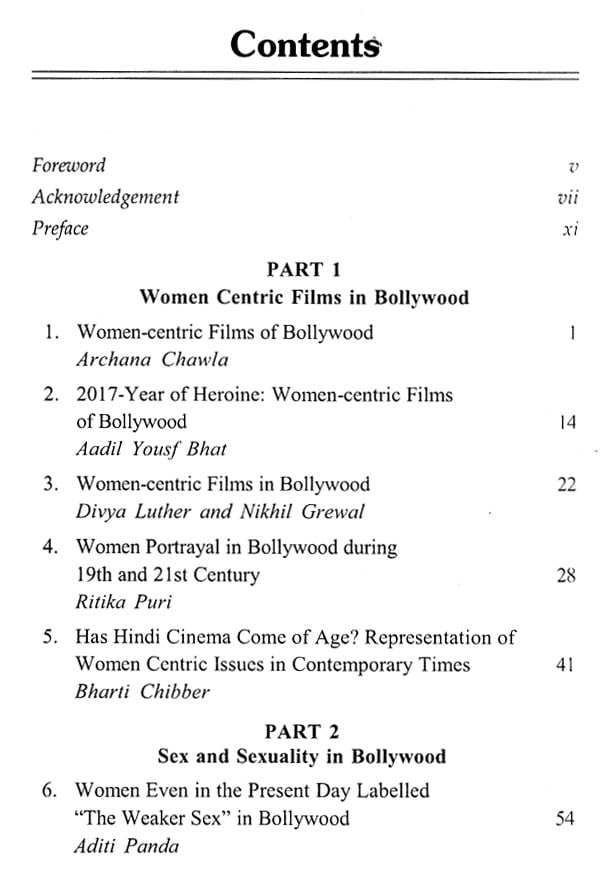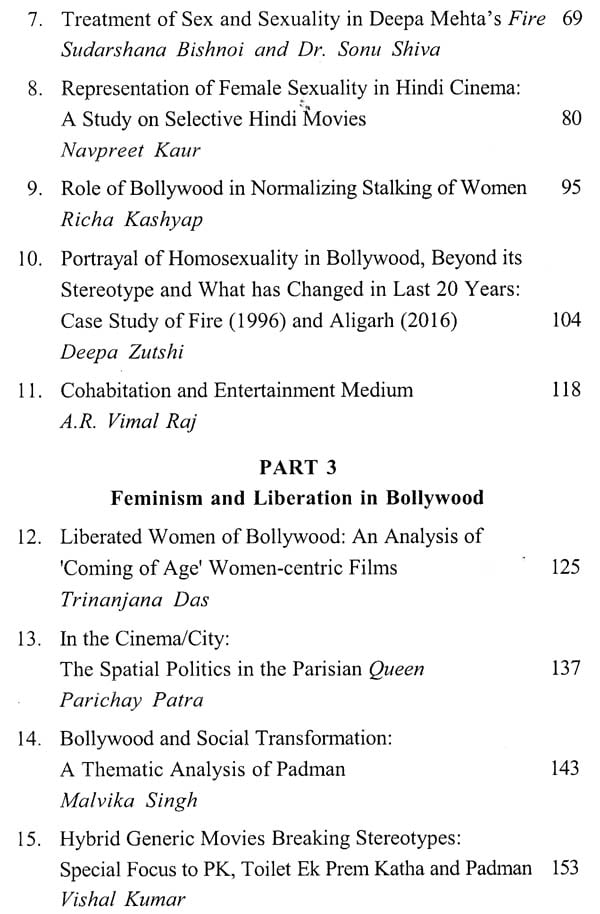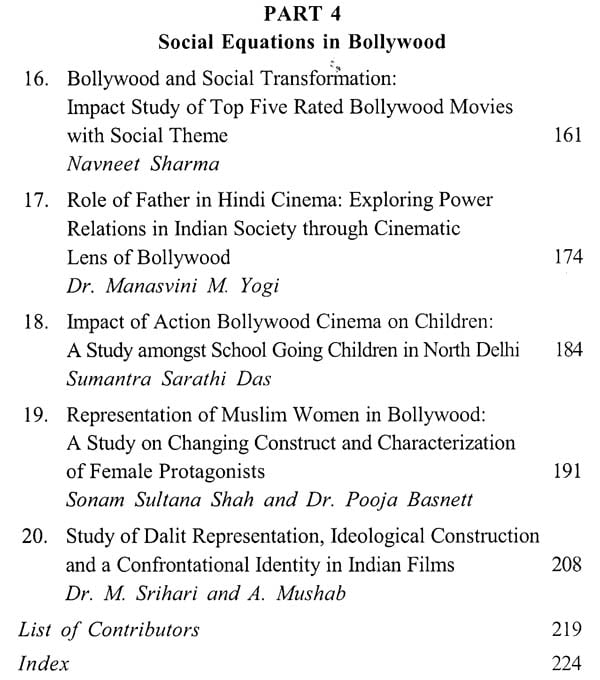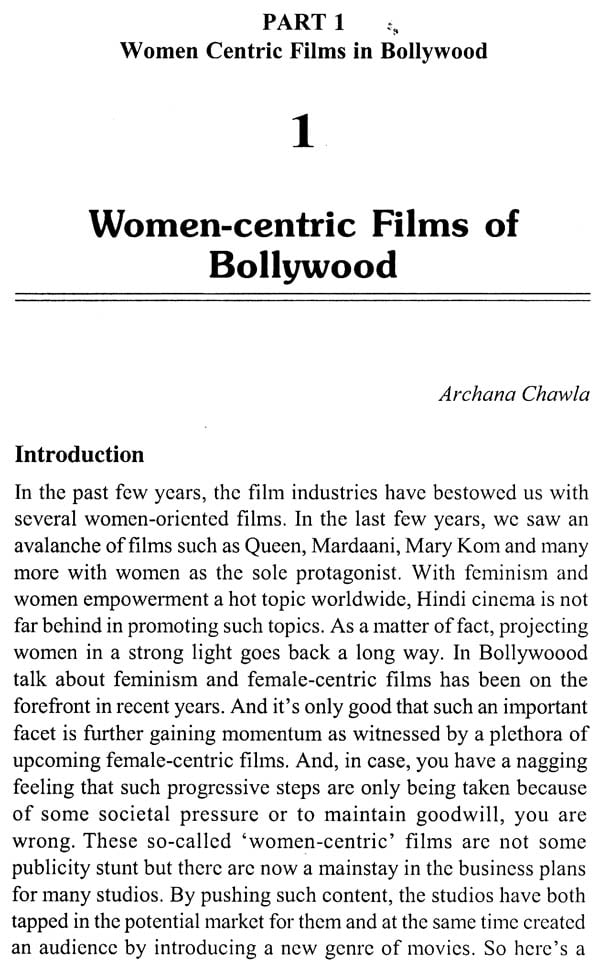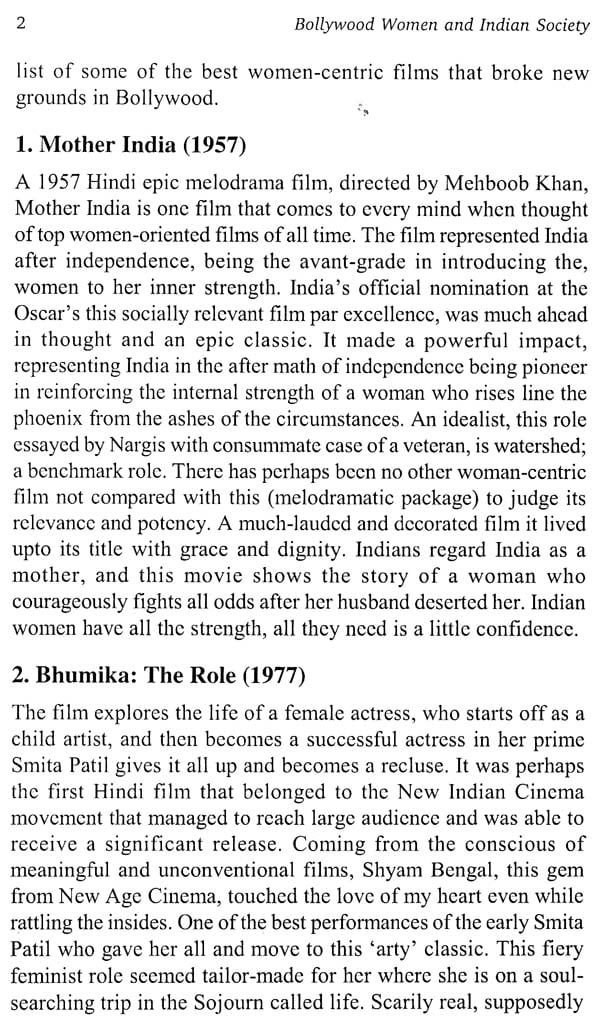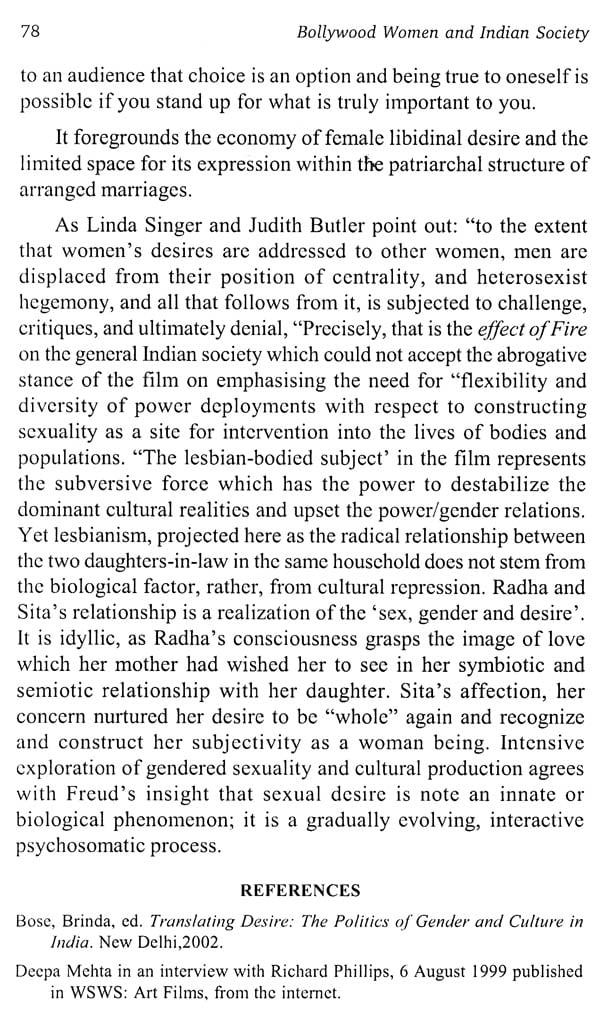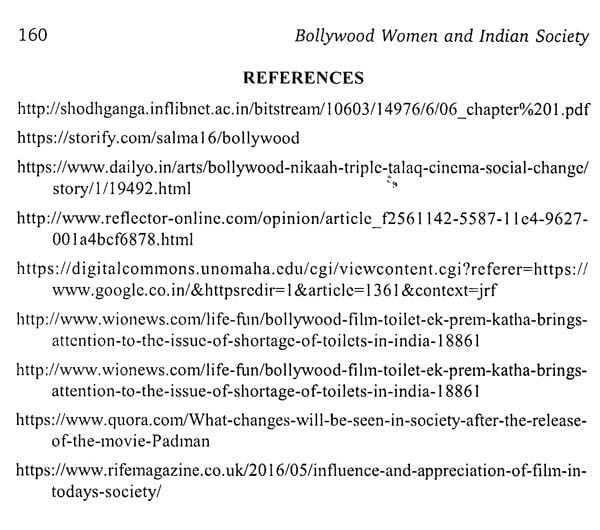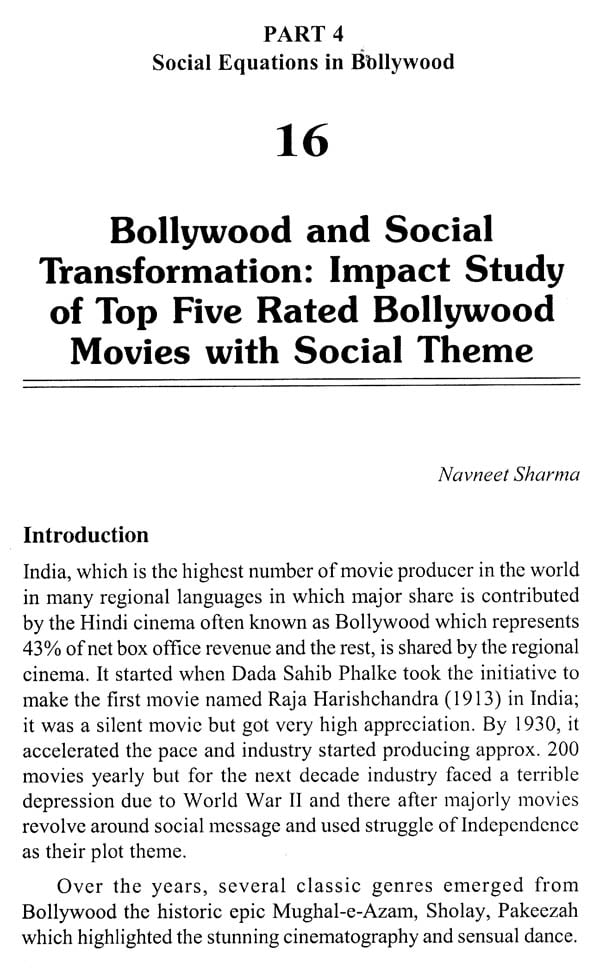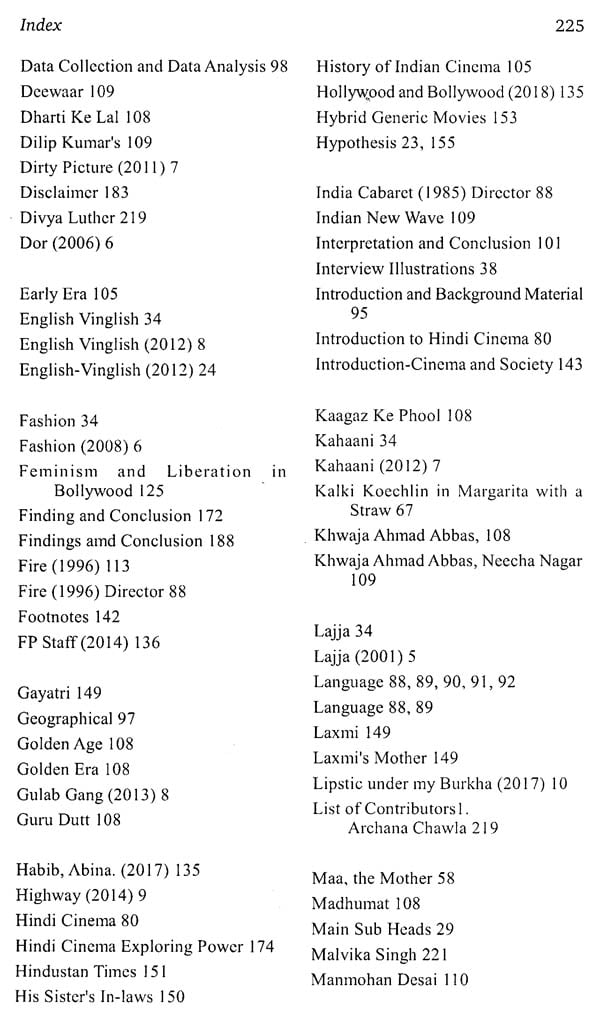
Bollywood Women and Indian Society
Book Specification
| Item Code: | NAW168 |
| Author: | Ambrish Saxena |
| Publisher: | KANISHKA PUBLISHERS |
| Language: | English |
| Edition: | 2019 |
| ISBN: | 9788193707074 |
| Pages: | 232 (14 B/W Illustrations) |
| Cover: | HARDCOVER |
| Other Details | 9.00 X 6.00 inch |
| Weight | 410 gm |
Book Description
Women have a distinguished place in Indian society and their status inside and outside home is always kept at a high pedestal. No doubt, we witness these days incidents of exploitation of women sexually and otherwise, but these could be aberrations. In India, family ties are strong and the focal point in these ties is women in different roles of mother, wife and sister.
Indian films portray women in different colours and shades. Bollywood i.e. Hindi cinema is flooded with women centric films if we look at the films particularly released since last decade. This book talks about this trend while analysing many such films in which lady actors play dominant roles.
The aspects of sex and sexuality have also been dominating Bollywood. So, many authors in this book have written about labelling of women as weaker sex and female sexuality. Also, Hindi films on the theme of homosexuality have been analysed by scholars. Even issues like the role of Bollywood in normalising stalking of women have been picked up for analyses.
To the delight of rational and progressive human beings issues of feminism. empowerment and emancipation of women in different forms are being chosen by contemporary Indian filmmakers. Films like Queen, Padman and Toilet Ek Prem Kasha have been picked up for study by researchers and you can read the findings of such studies in this book.
Films contribute to social transformation as well by rejecting social divide in the name of caste and community. While some films take up the issue of representation of Muslim women, others delve into issues of dalit representation. This book carries articles on such pertinent themes as interpreted in Indian films.
This book is broadly divided in four segments.
Part I: Women Centric Films in Bollywood
Part 2: Sex and Sexuality in Bollywood
Part 3: Feminism and Liberation in Bollywood
Part 4: Social Equations in Bollywood
Dr. Ambrish Saxena, Dean, DME Media School and Director. DME Studios and Production, is an accomplished media professional. educator, trainer, researcher, author, anchor and political analyst. He has worked at different media platforms ranging from theatre, puppetry. print, radio, television to films, before switching over to media academics.
Dr. Saxena has worked with many media groups, The Pioneer, Amrit Bazar Patrika, Aaj,JVG Times and ZEE. He has worked for the first ever TV news magazine Parakh during 1990s. He has been anchoring the highly rated programme of AIR FM Gold Market Mantra since the inception of the channel in 2001.
Dr. Saxena has academic association with more than 20 universities of India which include 4 central, 5 state and 9 private/deemed universities. He has 27 books to his credit as sole author, main author, chapter writer and editor. He has a long list of research papers presented in national (17) and international (26) seminars/conferences.
Dr. Saxena was part of the Indian Educators' delegation to China in 2008, participated in International Conference at RMIT University, Melbourne, Australia in 2016 and presented papers at Pre-Conference in Portland and Conference in Eugene. Oregon, United States, organized by IAMCR in 2018.
Manmeet Kaur is Assistant Professor in DNIE Media School at Delhi Metropolitan Education. Noida, affiliated to Guru Gobind Singh Indraprastha Unix ersity, Delhi. She was university topper in Guru Nanak Devi University in 2011. She qualified UGC-NET in the year 2012. She is pursuing PhD from Gum Nanak Dev University. Her area of specialisation is Film Studies. She has been presenting papers at national/international conferences and has published papers in research journals.
Divya Rastogi is Assistant Professor in DME Media School at Delhi Metropolitan Education, Noida (Affiliated to GGSIP University, Delhi). She is a pursuing PhD from Galgotias University, Greater Noida. She has more than eight years of academic and industry experience. Her specialisation is in the field of event management. She has contributed in various research journals. She has presented papers at seminar and conferences and have written chapters in books.
Cinema and television have long held mainstream entertainment appeal. From a mass media perspective, the content in movies or cinema can be classified vis-à-vis the status of society. There have been those that, upon release, mirror the life and times of the audience. Also present have been both regressive and progressive productions. There are in fact considerable themes into which productions can be categorised and various lenses through which they can be understood.
India produces numerous films in many languages every year. There is also endless hours of television programming churned out, day in and day out. Indian films have been widely recognised as a tool for soft power diplomacy too. Their reach and appeal have transcended borders and left a indelible impression on even India's fiercest foes. From my travels across South-East Asia I have also seen firsthand how Indian soap operas have a loyal and dedicated audiences well beyond India's borders, Add to this the heady mix of new networks that have aggregated content and are also producing Indian originals—Netflix, Amazon Prime Video, Alt Balaji etc., and the playing field has just expanded exponentially.
Given the scale and reach of Indian cinema and the nuances of the developing TV and networks platform, a study of the journey, direction and impact of these is very much in order. In fact the lack of periodic and systematic analysis of what we are watching, is simply astounding. This series of four books tries to fill this gap, and is a first in what should be a regular inquiry into the state of Indian productions.
These books contain research articles that analyse the various facets and developments in this field, and were presented at DME's second international ICAN — Indian Cinicma & Alternate Networks Conference. The Conference, partnered by Deakin University, Australia, and inaugurated at the India Habitat Centre on 16th November 2018, received exceptional support and contributions.
It is indeed heartening that we are sharing the spirit of inquiry and awareness with leading academicians of Australia, which is emerging as one of India's more prominent foreign connection.
An enormous amount of hard work has gone into organising of the conference as well as release of these books, and the ably led DME Media School must be congratulated on this feat.
I am hopeful that these papers contribute positively to the study of an industry that, while understandably acknowledged as a commercial giant, is often intellectually ignored.
Cinema makes a lasting effect on viewers' mind. It not only entertains but enlightens too. It is the real documentation of the culture, history, heritage and societal issues in a country. Cinema fascinates, it is alluring and captivating, and that is how it draws crowd to theatres all across the globe.
For the creative people cinema is a craft and not an academic subject. Learning the craft may be easy with an ingenious approach and skill friendly attitude. But, academics has its own importance. It gives a depth, an understanding to the producer of cinematic content. Educational institutions perform this job either through prescribing the subject in curriculum or organizing film appreciation workshops.
Besides academic and creative aspect, film making also involves technology and marketing. The arrival of OTT signals the departure of satellite age and internet based promotional tools have changed the dynamics of business. There is an earnest need to appreciate and comprehend these changes in whichever capacity we are associated with cinema whether as producer of content or merely consuming the content as viewer.
ICAN 2 held on November 16, 17 and 18, 2018, at DME provided a platform for all those who love cinema and want to live with cinema. Technical sessions (8), plenary sessions (3) and workshops (3) during International Conference on Indian Cinema and Alternate Networks delivered ample opportunities to film academia and film makers.
This conference looked at various aspects of Indian cinema while looking into how its reception and consumption, collaboration and distribution have changed over the years. Various aspects of Indian cinema were researched, analysed and discussed by scholars and filmmakers in different sessions of the conference.
ICAN 2 provided ocean of knowledge in terms of research based writings by eminent and emerging scholars from India and abroad. The research papers presented in this international conference are being published in the form of four books, three in English and one in Hindi. This book Bollywood Women and Indian Society is one of these books. The other two books are titled "World Cinema and Alternate Networks" and "Changing Trends of Indian Cinema".
This book Bollywood Women and Indian Society revolves around representation of women in Indian cinema and the depiction of film actresses in films. It analysis films about feminism and liberation of women and also deals with issues of sex and sexuality. This book covers discussion on films with issues like vulnerability of certain sections, caste and community divide and family ties.
This book brings before you diverse thoughts and approaches with regard to films dealing with varied subjects of society having emphasis on women. Many eminent media scholars, researchers and film experts have contributed to this book by penning down the outcome of their research and analysis on different themes. Hope, this book will benefit the cine lovers.
**Contents and Sample Pages**
